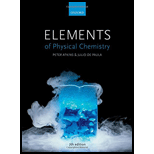
(a)
Interpretation:
The standard potential for given cell, the standard Gibbs energy and the enthalpy of the cell has to be calculated.
Concept Introduction:
In all electrochemical cells, oxidation occurs at anode and reduction occurs at cathode.
An anode is indicated by negative sign and cathode is indicated by the positive sign.
Electrons flow in the external circuit from the anode to the cathode.
Shorthand notation is used for describing the voltaic cell which gives simple idea about the cell and the reactions occurred in the electrodes in the cell.
Shorthand notation of Zn/Cu cell is,
The | notation indicates a phase boundary where the electrode and electrolyte are in physical contact.
The || notation indicates the salt bridge.
If additional reactants are required or specific products are formed, they are written with the solution separated by a comma or a semicolon.
Oxidation: Losing electrons, increasing oxidation number. And this process is occurred in anode.
Reduction: Gaining electron, decreasing oxidation number. This process is occurred in cathode.
Cell potential can be calculated from the electrode potentials as follows,
Electrochemical cells: Both oxidation and reduction occur at the same moment in an electrochemical cell. The oxidation process occurs at the anode while the reduction process occurs at the cathode in the cell. The concentration of the electrode (anode or cathode) in the half-cells and cell potential (voltage) can be calculated with the help of Nernst equation.
(b)
Interpretation:
The standard Gibbs energy of the cell at
Concept Introduction:
Electrochemical cell is a device that is used to either produce electricity from chemical reaction or induce chemical reactions using electric energy
In all electrochemical cells, oxidation occurs at anode and reduction occurs at cathode.
An anode is indicated by negative sign and cathode is indicated by the positive sign.
Electrons flow in the external circuit from the anode to the cathode.
Shorthand notation is used for describing the voltaic cell which gives simple idea about the cell and the reactions occurred in the electrodes in the cell.
Shorthand notation of Zn/Cu cell is,
The | notation indicates a phase boundary where the electrode and electrolyte are in physical contact.
The || notation indicates the salt bridge.
If additional reactants are required or specific products are formed, they are written with the solution separated by a comma or a semicolon.
Oxidation: Losing electrons, increasing oxidation number. And this process is occurred in anode.
Reduction: Gaining electron, decreasing oxidation number. This process is occurred in cathode.
Cell potential can be calculated from the electrode potentials as follows,
Electrochemical cells: Both oxidation and reduction occur at the same moment in an electrochemical cell. The oxidation process occurs at the anode while the reduction process occurs at the cathode in the cell. The concentration of the electrode (anode or cathode) in the half-cells and cell potential (voltage) can be calculated with the help of Nernst equation.
Want to see the full answer?
Check out a sample textbook solution
Chapter 5 Solutions
Elements Of Physical Chemistry
- Pls help.arrow_forward16) A 2.0 L flask containing 2.0 x 10-3 mol H2(g), 3.0 x 10-3 mol Cl2(g), and 4.0 x 10-3 mol HCl(g) at equilibrium. This system is represented by the following chemical equation: H2 (g) + Cl2 (g) → 2HCl(g) Calculate the equilibrium constant for this reaction.arrow_forward7) The pH of a 0.05M solution of HCl(aq) at 25°C is a. 1.3 b. 2.3 c. 3.3 d. 12.7arrow_forward
- 11) The Ksp expression for copper (II) sulfate is: a. [Cu2+][SO4²¯] b. [Cu²+]² [SO4²]² c. [Cu²+]²[SO4²] d. [CuSO4] 12) Which of the following is true about a chemical system in equilibrium? a. All chemical reactions have stopped b. The concentration of reactants is equal to the concertation of products c. The forward and reverse reaction rates become equal d. The system will remain at equilibrium regardless of any external factorsarrow_forward21) Explain the difference between the rate of a reaction and the extent of a reaction. Why are both of these concepts important, if you are a chemical engineer that is trying to develop a process to produce a large volume of a specific type of chemical compound?arrow_forwardPls help.arrow_forward
 ChemistryChemistryISBN:9781305957404Author:Steven S. Zumdahl, Susan A. Zumdahl, Donald J. DeCostePublisher:Cengage Learning
ChemistryChemistryISBN:9781305957404Author:Steven S. Zumdahl, Susan A. Zumdahl, Donald J. DeCostePublisher:Cengage Learning ChemistryChemistryISBN:9781259911156Author:Raymond Chang Dr., Jason Overby ProfessorPublisher:McGraw-Hill Education
ChemistryChemistryISBN:9781259911156Author:Raymond Chang Dr., Jason Overby ProfessorPublisher:McGraw-Hill Education Principles of Instrumental AnalysisChemistryISBN:9781305577213Author:Douglas A. Skoog, F. James Holler, Stanley R. CrouchPublisher:Cengage Learning
Principles of Instrumental AnalysisChemistryISBN:9781305577213Author:Douglas A. Skoog, F. James Holler, Stanley R. CrouchPublisher:Cengage Learning Organic ChemistryChemistryISBN:9780078021558Author:Janice Gorzynski Smith Dr.Publisher:McGraw-Hill Education
Organic ChemistryChemistryISBN:9780078021558Author:Janice Gorzynski Smith Dr.Publisher:McGraw-Hill Education Chemistry: Principles and ReactionsChemistryISBN:9781305079373Author:William L. Masterton, Cecile N. HurleyPublisher:Cengage Learning
Chemistry: Principles and ReactionsChemistryISBN:9781305079373Author:William L. Masterton, Cecile N. HurleyPublisher:Cengage Learning Elementary Principles of Chemical Processes, Bind...ChemistryISBN:9781118431221Author:Richard M. Felder, Ronald W. Rousseau, Lisa G. BullardPublisher:WILEY
Elementary Principles of Chemical Processes, Bind...ChemistryISBN:9781118431221Author:Richard M. Felder, Ronald W. Rousseau, Lisa G. BullardPublisher:WILEY





